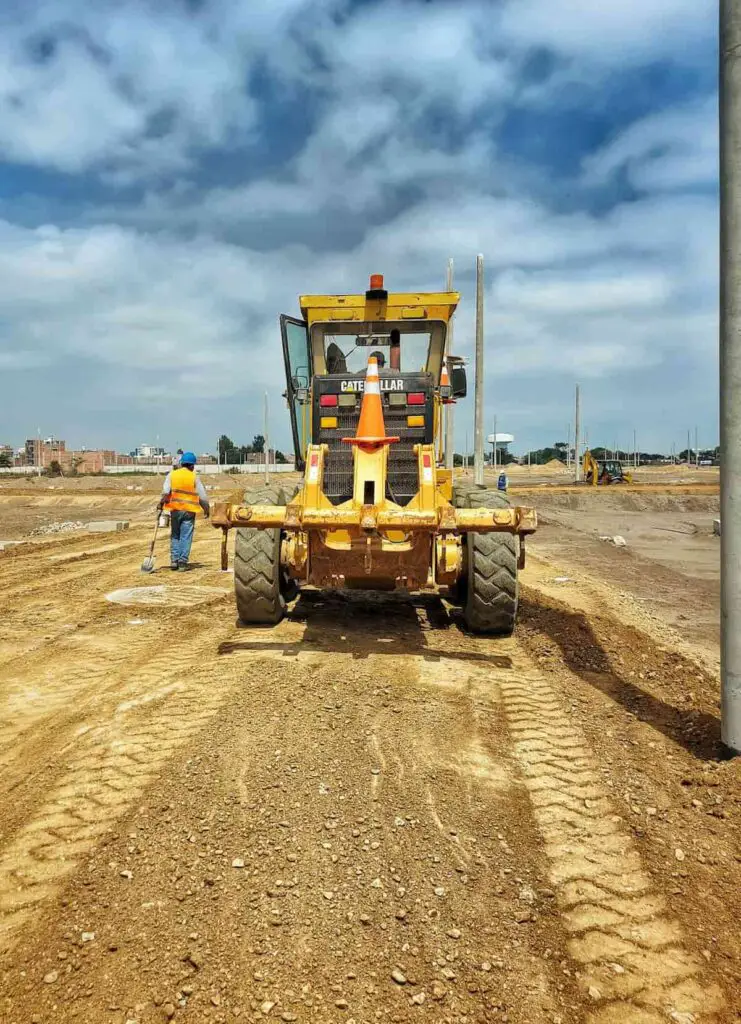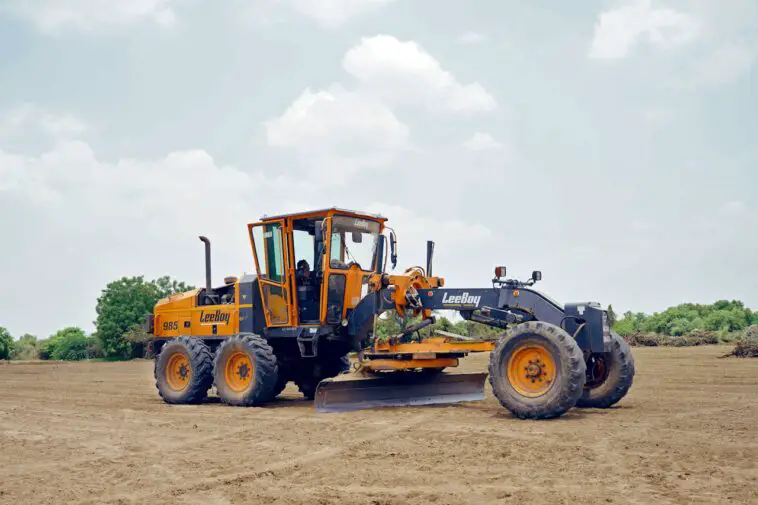A motor grader is a construction machine used to create flat surfaces. It smooths out terrain for roadwork, foundations, and landscaping.
Motor graders play a significant role in road construction and maintenance. They prepare the ground for paving by making it flat and even.
They can also improve the smoothness of an existing road, making sure it has the right slopes. These machines are instantly recognizable by their long adjustable blade between the front and rear axles.
Graders are skillfully designed machines to cut, spread, and level materials. They are also capable of performing tasks like trenching and scarifying, which helps in the installation of pipelines and cables.
The operators who use motor graders must possess precision and expertise, as these versatile vehicles are crucial in laying the foundation for infrastructure projects.
Their ability to finish and fine-tune a surface makes them indispensable for both initial construction and subsequent road maintenance.
Functions Of A Motor Grader
A motor grader, also known as a road grader, is a versatile piece of construction equipment. Its primary role is in the delicate gradation of soil, a critical step in constructing and maintaining roads.
Let’s explore the indispensable functions of a motor grader.
Grading Roads
One of the essential tasks of a motor grader is to grade roads. This process ensures roads have the correct slope and are smooth for safe driving.
- Even Distribution: Graders spread soil and gravel evenly across the roadbed.
- Surface Shaping: They sculpt the roadway to the required curvature.
- Final Touch: They provide the finishing touches after heavier construction equipment has done the bulk work.
Leveling Surfaces
Motor graders excel in creating flat and even surfaces. Their precision blades adjust to achieve a level grade.
- Preparing foundation layers for buildings and pavements.
- Smoothing out soil in agricultural fields before planting.
- Leveling ground for sports fields and other recreational areas.
Creating Drainage Systems
Effective drainage is vital for road longevity and safety. Motor graders carve out ditches and slopes for water runoff.
| Task | Function |
| Ditch Formation | They cut ditches beside roads for proper water drainage. |
| Bank Sloping | They angle the sides of roads to direct water away. |
| Waterways | They create channels to control the flow of water in an area. |

Components Of A Motor Grader
The motor grader is an important machine used for road construction and maintenance. It consists of various essential components, each with a crucial role.
Anyone in the construction industry or anyone who is planning to buy a new or used motor grader for sale needs to have a clear understanding of these parts.
Let’s take a closer look at the main components of a motor grader.
Blade
The moldboard, also known as the blade, is the most important part of a motor grader. It is a large metal plate used for cutting, spreading, and leveling materials.
Operators can make precise adjustments to the blade’s angle, tilt, and height, which are critical to the grader’s effectiveness. The blade’s capabilities are essential for the grader’s successful performance.
Wheels And Tires
- Durable tires: Provide traction and stability.
- Wheels configuration: Often, six wheels enhance maneuverability.
Engine
Graders have powerful engines that drive the machine and operate the hydraulic system. The engine’s horsepower is a crucial factor in performance.
Cab
The cab is the operator’s workplace. It features controls and is designed for comfort and visibility. Advanced graders have cabs with air conditioning, heating, and ergonomic seating.
Hydraulic System
The hydraulic system powers the blade movement. It ensures smooth operation and precise control of the blade for effective grading.
Types Of Motor Graders
A motor grader, often known as a road grader, is a versatile construction machine that shapes the ground to a desired level or grade.
There are different types of motor graders, each serving its unique purpose in construction and road making.
Rigid Frame Graders
Rigid frame graders stand out in their simplicity of design. The moldboard, or blade, is attached to a rigid frame. These graders are best for tasks in confined areas.
Articulated Frame Graders
Articulated frame graders have a pivot point between the front and rear axles. This makes them highly flexible. They’re great for turns and for working on uneven terrain.
Tandem Graders
Tandem graders are equipped with two sets of wheels. They offer better traction and stability. Ideal for leveling large, open spaces.
Applications Of Motor Graders
Motor graders play a crucial role in various industries. From construction to agriculture, these powerful machines shape and level the ground.
Let’s dive into their diverse applications and understand why they’re a go-to for professionals.
Road Construction
Motor graders ensure roads are smooth and safe. They cut, spread, and level material to form the roadbed. Gradual slopes for water runoff are also their handiwork. Here’s what they can do:
- Prepare foundation: They set the stage for asphalt laying.
- Grade surfaces: Unevenness disappears with their precision.
- Finishing touches: For a road’s final shape, they’re essential.
Maintaining Dirt And Gravel Roads
Dirt and gravel roads need regular care. Graders maintain these paths well. They clear ruts and restore smoothness. Issues like potholes are quickly fixed. Maintenance actions involve:
- Creating a crown to manage drainage.
- Eliminating washboarding and ruts.
- Blending and redistributing surface material.
Mining Operations
In mining, motor graders are essential. They manage haul roads, ensuring trucks can pass. Safety and efficiency depend on their work. Graders handle tasks such as:
- Leveling: They flatten areas for drilling rigs.
- Haul road upkeep: Keeps transportation routes optimal.
- Site cleanup: Removing debris is a breeze.
Snow Removal
When snow covers roads, graders get to work. They’re better than plows in some cases. They scrape ice and packed snow efficiently. Their blades adjust for precise snow removal jobs:
- Heavy snow lifting: Blades go deep to clear ways.
- Ice breakup: Metal tips crack even tough ice.
- Spreader attachment: Some grade and salt roads together.
Agricultural Land Leveling
Agriculture benefits from level fields. Graders create the perfect terrain for crops. They promote better irrigation and yield results like:
- Erosion prevention: Proper grading stops soil loss.
- Efficient water use: Fields evenly distribute water.
- Yield improvement: A flat field grows more produce.
Operating A Motor Grader
Operating a motor grader involves precision and skill. This machine shapes and levels surfaces with unparalleled finesse. It’s essential in construction and road maintenance to create smooth and flat surfaces.
Learning to operate one efficiently requires understanding the machinery, adhering to safety protocols, and mastering specific techniques.
Preparation
Begin with a thorough inspection. Check the grader’s components, such as the blade and engine. Validate fluid levels, tire pressure, and control mechanisms. Setting up the grader correctly lays the groundwork for effective operation.
- Checklist of pre-operational requirements
- Adjustment of mirrors and seating for visibility and comfort
- Familiarization with control panels and levers
Safety Considerations
Safety is paramount. Wear the required personal protective equipment (PPE), secure the machine, and be mindful of your surroundings. Always maintain clear communication with ground personnel.
- Don personal protective equipment
- Implement lockout-tagout procedures if necessary
- Stay aware of the job site and nearby workers
Techniques And Tips
Effective grading techniques are essential. They ensure precision in surface finishing. Start with light cuts to establish control. Graders are powerful but require soft hands-on controls for accuracy.
| Technique | Description | Benefit |
| Blade Positioning | Set the angle appropriate to the task | Maximizes efficiency |
| Controlled Movements | Smooth operations prevent disruptions | Enhances surface finish |
| Progressive Passes | Gradual removal of material | Reduces error |
- Maintain a steady speed
- Use benchmarks for consistency
- Continuous assessment for adjustments
Advancements In Motor Grader Technology
As demand for precision and efficiency increases, motor grader technology constantly evolves. These advancements improve the performance of motor graders, making them indispensable in construction and maintenance.
GPS and GNSS Integration
Accurate grading relies on precise location data. Modern motor graders come with integrated GPS and GNSS systems. These systems provide real-time data, helping operators achieve high-precision results.
- Enhanced accuracy in grading operations
- Reduced need for additional surveying
- Time and cost savings on projects
Grade Control Systems
Grade control systems are revolutionizing motor grader functionalities. These systems automate blade movements for optimal grading efficiency. They allow for:
- Consistent grade quality
- Less rework required
- Improved operator performance
Telematics And Remote Monitoring
Telematics in motor graders provide essential insights. They help in monitoring equipment health and operation. Benefits include:
| Feature | Benefit |
| Real-time tracking | Prevents theft and unauthorized use |
| Maintenance alerts | Reduces downtime |
| Operation analytics | Enhances productivity |
Frequently Asked Questions About Motor Grader
What Is The Primary Function Of A Motor Grader?
A motor grader’s primary function is to grade surfaces by creating flat or sloped planes. It precisely levels and shapes dirt or gravel roads and prepares the base for laying asphalt.
How Does A Motor Grader Contribute To Road Construction?
A motor grader shapes the roadbed during road construction to ensure a level base. This is crucial for proper drainage and a smooth driving surface. It also helps cut, spread, and level material.
Can Motor Graders Perform Heavy-duty Tasks?
Yes, motor graders are capable of heavy-duty tasks. Their powerful engines and adjustable blades handle rough grading, earthmoving, and even snow removal.
Are Motor Graders Used For Agricultural Purposes?
Motor graders can be used in agriculture for tasks such as leveling land for irrigation projects and creating terraced fields. Their versatility makes them suitable for various terrain types.
Conclusion
Understanding the versatility of a motor grader cannot be overstated. These powerful machines shape the land to pave the way for progress.
They’re essential in construction, road maintenance, and many earthmoving projects. By now, you should have a clear perspective on their operation and significance.
For any venture involving leveling or terrain, motor graders are unsung heroes, seamlessly laying the groundwork for our daily lives.




